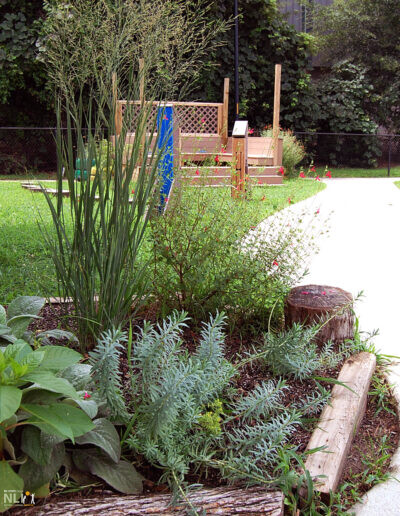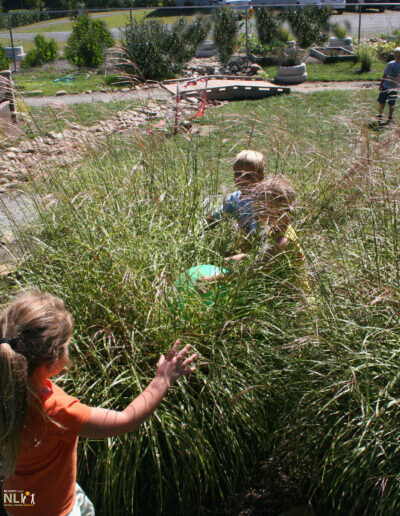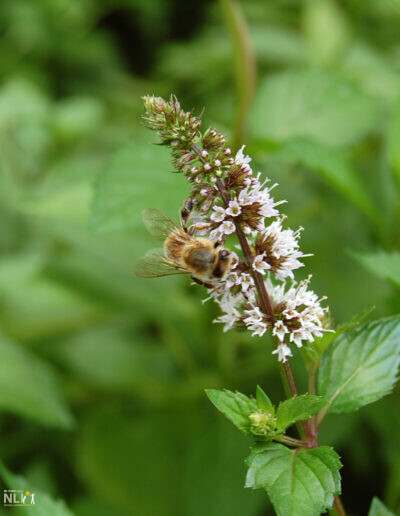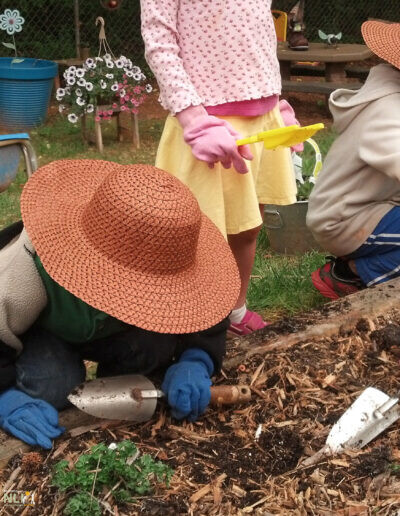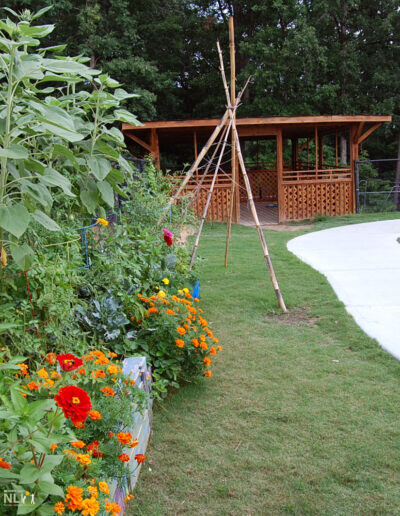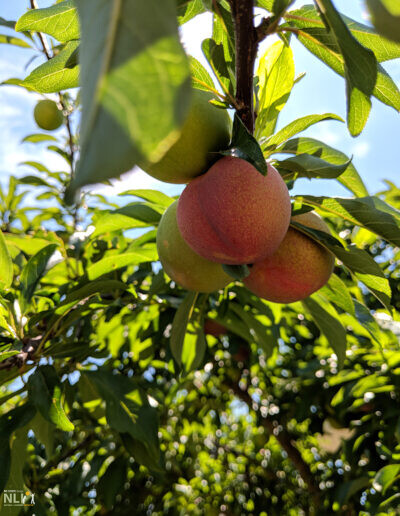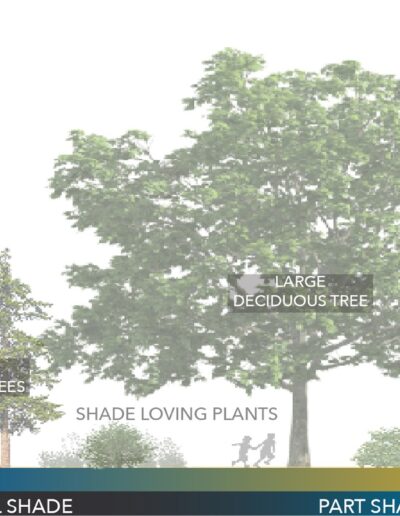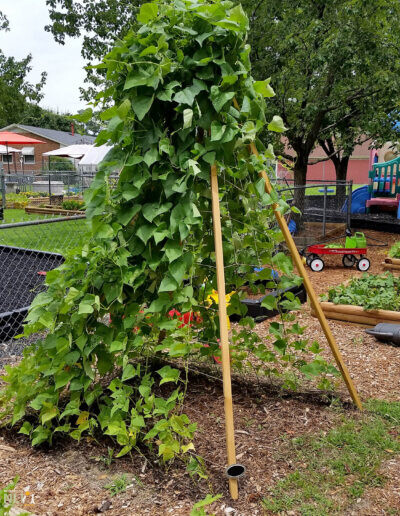28. Plants for Outdoor Learning Environments
Plants are a critical outdoor learning environment (OLE) best practice. Different species can provide shade, visual screens, wind barriers, and enhance seasonal play opportunities. For children, plants create a magical world where imaginations can endlessly roam. Natural loose parts, such as twigs and seeds, are used as props to stimulate imaginative play. Plants improve outdoor comfort, motivate children to spend more time outside, and add cost-effective play and learning value to the OLE.
Plant Types
Understanding different plant types enable wise plant selection, cost-effective purchase decisions, and efficient installation practices. This InfoSheet introduces plant types and guides plant selection to create successful, naturalized OLEs.
Trees provide shade, visual screens, and wildlife habitat. They also serve as key edible landscape components. Specific species, such as fig trees, provide climbing opportunities.
Shrubs provide interesting foliage, flowers, and fragrance close to the ground for children to experience and enjoy. Some shrub species provide edible fruit; many attract birds, butterflies, and other pollinators.
Vines typically grow fast, climbing up and on any surface they encounter—this makes them especially useful for naturalizing fences, arbors, and pergolas. Some vines, such as blackberry or grape, produce edible fruits, adding value to an OLE.
Ornamental Grasses are tough and affordable perennial plants that look good year-round, even during the dormant winter season. They are often used to create informal mazes that can take heavy foot traffic. Ornamental grasses provide textural variety and play props.
Groundcovers can be used to naturalize ground surfaces, including areas under trees and shrubs. Groundcovers include some herbs (“stepables”) that are particularly effective when planted between paving stones.
Perennial flowering plants add a diversity of color, fragrance, and texture to the OLE. Perennials can provide habitat for diverse wildlife, including birds and pollinators. Many perennials produce beautiful flowers and go through fascinating growth cycles. Consider installing a “cutting bed,” supplying flowers for indoor decoration and enjoyment.
Annual flowering plants are a great way to add instant color to the OLE, especially when other plants are dormant. Annuals allow children to experience the life cycle, beginning with planting seeds and ending with cutting flowers or harvesting vegetables. A disadvantage of annuals is that they must be replaced each year, so carefully consider the location and amount of annual planting—fruit and vegetable gardens should be the primary use of annuals in outdoor learning environments.
Plant Characteristics
Deciduous plants lose their leaves during the winter. Through continuous cycles of change, deciduous plants provide multiple opportunities for learning: buds, fresh leaves, blooming flowers, and seeds can become props for imaginative and educational play.
Evergreen plants keep their leaves year-round. They provide patches of green after deciduous plants have dropped their leaves, and help the OLE avoid a desolate winter appearance. In summer they provide cool, deep shade.
Perennial plants come back yearly and grow larger until they reach maturity.
Annual plants die at the end of the growing season.
Native plants are indigenous or well-adapted to the region. They tend to be more hardy and drought-tolerant than non-natives and should be used whenever possible.
Edible Plants in the OLE
Research shows that children are more likely to try a new fruit or vegetable if they plant, grow, and harvest it. At childcare centers, edible landscapes offer the potential for children to learn healthy eating habits that will stay with them through life.
Perennial edible plants include fruiting trees, shrubs, vines, and perennial vegetables. Full sun is required for most species and some have specific cultivation conditions, including soil quality and/or irrigation needs. Consider planting in groves or cultivated along a south-facing wall. In spring, fruit trees become magical places as pollinators work busily overhead and petals fall like snow. In summer, fruit trees can contribute shade. Autumn harvests provide curricular and nutritional opportunities. Fruit trees gain in value each year—an investment in healthy enjoyment for generations to come.
Designated vegetable gardens can be installed at ground level or in raised beds containing vegetables and perennial herbs to introduce new scents and tastes. Because annual vegetables grow so fast and dynamically, they provide diverse, hands-on, seasonal learning experiences. Thoughtfully planned annuals can provide opportunities for children to care for the garden almost year-round.
Resources:
- NCSU Cooperative Extension Gardener Handbook
- North Carolina Extension Gardener Plant Toolbox
- U.S. Department of Agriculture Plant Hardiness Zone Map
- PlayCore Play Value Plant Database
Lush perennial plantings of different textures and height add sensory interest and differentiate settings.
Children planting together reinforces the notion of collective effort to achieve a result that all can enjoy.
HELPING PLANTS THRIVE
Individual species adapted to grow under particular conditions. Knowing some basics about how plants relate to each other and grow as a unit can guide successful plant placement. Consult a local plant expert for advice on specific growing conditions of a given site.
Sun requirements vary greatly according to species, ranging from full sun to full shade. Be sure to read planting or transplanting instructions and plan accordingly.
- Full sun: at least 6 full hours of direct sun
- Part sun/part shade: between 3–6 hours of sun each day in the morning and/or early afternoon
- Full shade: less than 3 hours of direct sunlight each day with filtered sunlight during the rest of the day
Water. All plants need water, some more than others. Adequate, periodic watering is essential depending on rainfall and season. Install hose bibs close by to avoid long, cumbersome hoses. Group plants with similar irrigation requirements and choose drought-tolerant species. Spread natural, plant-based mulch, such as shredded bark, 2–3 inches deep at the base of newly installed plants—this helps to conserve moisture and reduce weed growth.
Soil. Well-drained, high-quality soil is essential for healthy plant growth. Use potting soil for containers or amend native soil with compost to ensure that plants grow well.
Hardiness. A plant’s designated USDA Hardiness Zone is crucial for understanding environmental requirements, including temperature tolerances. Refer to the USDA Hardiness zone map, referenced below, to learn more about regional hardiness zones.
Weed and pest control. Remove weeds and pests by hand. Avoid the use of pesticides and herbicides in childcare OLEs. They may be harmful to children and other living creatures that use plants as food sources.
Pruning. Most plant types benefit from yearly pruning. The practice of pruning will keep plants healthy and encourage new growth. The optimal time to prune depends on the type of plant. Flowering trees, shrubs, and vines prefer to be pruned in the late/winter and early spring, while some evergreens prefer the early spring or no pruning at all. Consult a local expert or cooperative extension for pruning guidance to ensure that OLE plants look happy and healthy.
SELECTING PLANTS FOR PLAY AND LEARNING
When selecting plants for outdoor learning environments, consider the following best-practice criteria for successful nature-based play and learning. Plants should: be non-toxic; add play value such as sensory qualities or loose parts that engage children; offer year-round interest, including changing leaves and dropping seed-pods; and provide child-scale spaces, meaning they are sized so children can touch and interact with plant material at their height.
RECOMMENDED PLANT LIST
The list below identifies plants that are well suited to outdoor learning environments in the North Carolina Piedmont Region. To learn more about OLE plants for other regions, consult local cooperative extension offices and the wonderful PlayCore Play Value Plant Database.
Small to Medium Trees
Amelanchier x grandiflora, Autumn brilliance serviceberry
Cercis canadensis, Eastern redbud
Lagerstroemia indica, Crape myrtle
Magnolia ‘Jane’, Jane saucer magnolia
Magnolia grandiflora ‘Little Gem’, Little gem magnolia
Magnolia virginiana, Sweetbay magnolia
Myrica cerifera, Wax myrtle
Shrubs
Buddleja davidii ‘Blue Chip’, Blue Chip dwarf butterflybush
Camellia sasanqua, Camellia
Cryptomeria ‘Globosa Nana’, Globosa nana dwarf japanese cedar
Gardenia jasminoides ‘Frostproof’, Frostproof gardenia
Itea virginica ‘Henry’s Garnet’, Henry’s garnet virginia sweetspire
Loropetalum chinense ‘Daruma’, Daruma loropetalum
Spiraea japonica ‘Goldmound’, Goldmound spiraea
Ornamental Grasses
Juncus effusus, Common rush
Liriope muscari ‘Variegata’, Variegated monkey grass
Muhlenbergia capillaris, Pink muhly grass
Pennisetum alopecuroides ‘Hameln’, Hameln dwarf fountain grass
Perennials
Aster dumosus ‘Woods Blue’, Woods blue aster
Canna spp., Canna lily
Dryopteris erythrosora ‘Brilliance’, Brilliance autumn fern
Hemerocallis spp., Day Lily
Lavandula x intermedia ‘Phenomenal’, Phenomenal lavender
Leucanthemum x superbum ‘Becky’, Becky’s daisy
Nepeta x faassenii ‘Walker’s Low’, Walker’s low catmint
Salvia rosmarinus, Rosemary
Rudbeckia fulgida ‘Goldsturm’, Goldsturm black-eyed Susan
Salvia microphylla ‘Hot Lips’, Hot lips salvia
Stachys byzantina, Lamb’s ear
Thymus vulgaris, Common thyme
Groundcovers
Acorus gramineus ‘Ogon’, Ogon sweetflag
Ajuga reptans, Bugleweed
Ophiopogon japonicus ‘Nana’, Dwarf mondo grass
Thymus serpyllum, Creeping thyme
Edible Trees
Diospyros kaki ‘Fuyu’, Fuyu asian persimmon
Ficus ‘Brown Turkey’, Brown turkey fig
Malus ‘Gala’*, Gala apple
Malus ‘Red Delicious’*, Red delicious apple
Prunus salicina ‘Methley’, Methley japanese plum
Pyrus pyrifolia ‘Twentieth Century’ Twentieth century asian pear
*Apples require cross pollination– Gala and Red Delicious should be planted together for fruit production
Edible Shrubs
Vaccinium asheii ‘Climax’*, Climax blueberry
Vaccinium asheii ‘Premier’*, Premier blueberry
Vaccinium asheii ‘Tifblue’*,Tifblue blueberry
Rubus ‘Arapahoe’**, Arapahoe thornless blackberry
Rubus ‘Natchez’**, Natchez thornless blackberry
Rubus ‘Von’**, Von thornless blackberry
*Blueberries perform best when two or more different cultivars are planted
**Requires support such as a trellis or fence
Edible Vines
Vitus rotundifolia ‘Carlos’, Carlos muscadine grape
Vitus rotundifolia ‘Noble’, Noble muscadine grape

